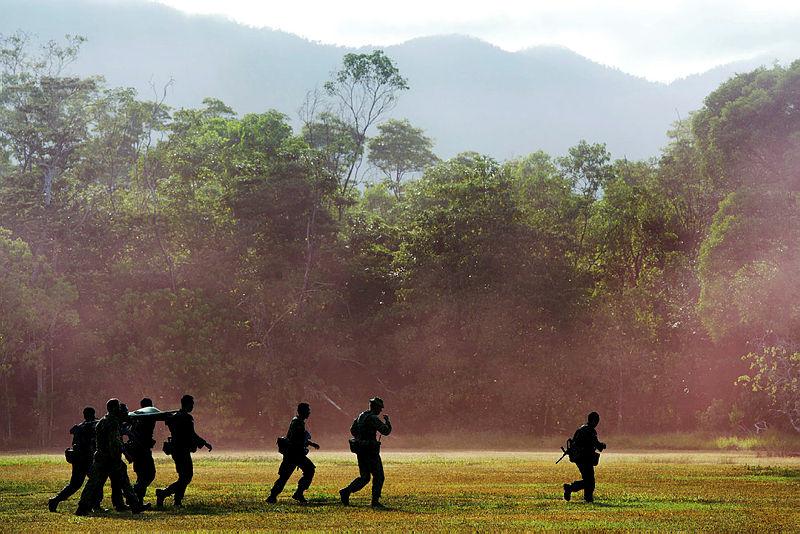
The release of 2016 Defence White Paper signifies a much sharper focus from Australia on maritime Southeast Asia. Geography dictates that whenever Canberra looks at maritime Southeast Asia, the first country that appears in its strategic outlook is Indonesia. Indeed, the 2016 DWP reiterates Indonesia’s strategic importance to Australia as a ‘near neighbour’ (paragraph 2.81). While Indonesia’s strategic importance is something that Australia seems obliged to acknowledge heavily in each iteration of the Defence White Paper, the feeling isn’t always mutual. Indonesia’s 2008 DWP, for instance, mentions Australia nine times whereas Australia’s 2009 and 2013 DWPs mention Indonesia 21 and 32 times, respectively. The 2016 DWP is aware of this asymmetry. While the previous two Australian DWPs denote the relationship with Indonesia as Australia’s ‘most important’ in the region, the 2016 DWP only regards it as ‘vital’, offering a more realistic and productive view of the relationship.
For instance, while the 2009 DWP considers the potential of ‘an authoritarian or overly nationalistic regime in Jakarta’ as creating ‘strategic risks for its neighbours’ (4.33), the 2016 DWP excluded such references, as if to convey a greater Australian confidence in Indonesia’s potential as a reliable security partner.
Australia and Indonesia certainly share some common security interests that are discussed in the 2016 DWP, including ‘the security and stability of the maritime domains that we share, the free movement of trade and investment through these domains, and countering terrorism and people smuggling in our region’ (5.34). But those are only incidental intersections between different strategic outlooks, from which our respective strategic policies follow.
That raises a question about the extent to which Indonesia shares Canberra’s unqualified strategic assessment of the United States as a ‘stabilising force in the Indo–Pacific’ (2.80). While Indonesia certainly views the US’ role in regional security and stability as indispensable, the maintenance of US primacy in the region isn’t a sine qua non. Rather, Indonesia thinks that the region’s security and stability is best guaranteed through collective commitments towards shared norms and institutions (embodied within ASEAN-centric architectures) in which all the major powers become their guarantors and are equally responsible for their preservation. Former Indonesian Foreign Minister Marty Natalegawa’s ‘dynamic equilibrium’ concept reflects this sentiment in a way that still resonates within Indonesia’s present strategic outlook. The differences between Australian and Indonesian strategic outlooks shouldn’t be overstated, but they could become potential future stumbling blocks on the road toward a deeper strategic partnership.
The Australia–Indonesia relationship often depends on how Australia regards its role in Southeast Asia. That’s got nothing to do with the dichotomy between Australia’s history and geography, as John Howard once said, but is more about Australia’s ability and willingness to operate as an autonomous actor in response to strategic challenges in the region. Often Indonesia (and others in the region) finds it hard to distinguish Australia’s individual strategic policies from the policies that are implemented merely as demonstrations of Australian commitment to the US alliance, especially as the latter policies can be cloaked in the former. That’s particularly pertinent in light of Australia’s reactionary assertiveness, potentially through conducting military freedom of navigation operations (FONOPs), against China’s excessive maritime claims in the South China Sea.
The 2016 DWP notes Australia’s legitimate concerns about the militarisation and fortification of disputed features and waters in the South China Sea. Although the position is addressed to all claimants, China in particular is singled out, given the pace and scale of its reclamation activities relative to other parties. Indonesia is equally, if not more, alarmed as Australia is about China’s excessive maritime claims. But the two countries may be driven by different motives when considering their responses to this challenge. Despite its self-proclaimed non-claimant status, Indonesia is increasingly worried about the potential implications of the disputes on the Natuna Islands, and anxious about the Sino–American geostrategic brinkmanship in the region towards ASEAN’s unity and centrality, in which Indonesia’s credibility as a de facto primus inter pares is at stake. In contrast, Australia may think that challenging China due to its commitment towards the US alliance is as important as its own geostrategic and geoeconomic reasons.
Rather than simply acting out of the commitment to the US alliance, Australia’s South China Sea policies that are promoted largely by its own national interests (such as the maintenance of UNCLOS-based maritime order) could actually elicit greater appreciation from Indonesia and perhaps Southeast Asia. This would mean that Australia’s efforts shouldn’t only be about restraining China from imposing the 9-dash line, but also about mitigating the Sino–American geostrategic contest in the South China Sea.
Yet, the South China Sea could also become an arena where Australian and Indonesian strategic outlooks increasingly converge, and create a stimulus for a closer defence relationship. Indeed, with the 2016 DWP hailing ‘Indonesia’s increased focus on maritime affairs’ and Australia’s goal of seeking ‘greater cooperation on maritime security activities that contribute to a stable and prosperous region’ (5.34), the South China Sea could serve as a wake-up call for the two countries to consider more sophisticated maritime security cooperation.
Australia is starting to recognise Indonesia’s military modernisation and growing influence as ‘positive developments’ (2.83), which is a signal of Australia’s willingness to ameliorate the seemingly ubiquitous security dilemma with Indonesia. However, it takes two to tango: Indonesia’s next Defence White Paper could make positive reference to Australia’s military build-up as a continuation of its commitment to improving bilateral defence cooperation.